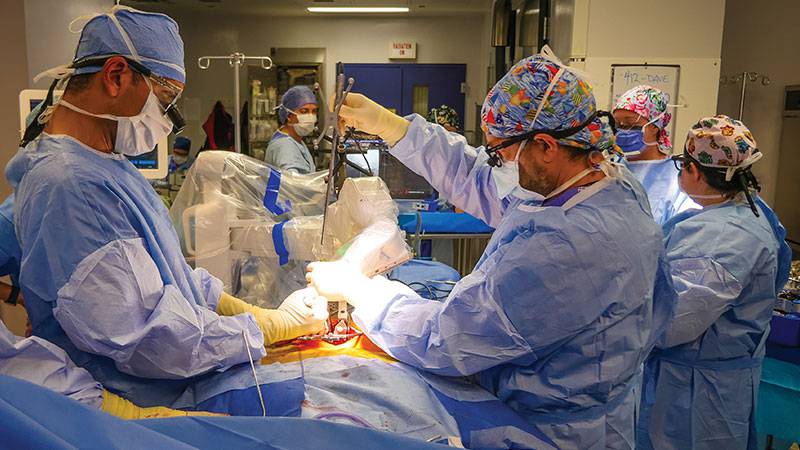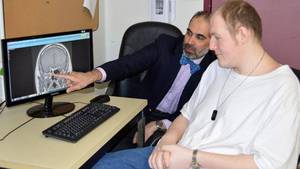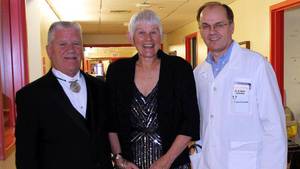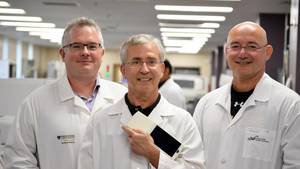This past July, healthcare history was made as the QEII Health Sciences Centre became the first Canadian hospital to perform a patient procedure using the MAZOR X spinal robot. This first-in-Canada procedure was performed by Dr. Sean Christie, QEII neurosurgeon, solidifying the QEII’s place as a national leader in spinal surgery and robotics.
But for the patients who are directly benefitting from this advanced technology, this innovative milestone is also life-changing — providing access to some of the country’s most personalized surgical care.
No longer a futuristic notion, robotics is rapidly transforming the delivery of health care around the world; the QEII is no exception. This summer, the MAZOR X became the fourth surgical robot to call the QEII home.
This cutting-edge technology combines an innovative robotic arm with an advanced surgical navigation system to facilitate some of the most precise, personalized surgeries possible. The QEII Foundation is on a mission to raise $3 million to fully fund the robot and contribute to the accompanying research and evaluation. It’s a prime example of the QEII Foundation’s $100-million We Are campaign at work, which aims to revolutionize health care in our region through philanthropy.
The QEII’s new MAZOR X spinal robot uses 3D cameras to develop a 3D simulation of the robotic procedure, which can be planned and visualized prior to the actual surgery or in real-time in the OR. This planning allows the surgeon to completely tailor the procedure to the patient and, in some cases, operate in smaller, more precise areas of the spine.
“When it comes to the spine and spinal cord, millimetres can literally mean the difference between someone walking and someone bedridden,” says Dr. David Clarke, head of QEII neurosurgery. “What the robot gives us is solid guidance that we’re not half a degree off. That precision is unmatched.”
It’s one of the many benefits echoed by Dr. Christie, who’s thrilled that the QEII’s spine program can begin introducing robotic-assisted procedures to select spinal patients.
“This increased precision can result in shorter hospital stays, less impact on healthy tissues, quicker recoveries and less pain — all of which can have an immeasurable impact on the patient,” says Dr. Christie.
He adds that early data in the U.S. suggest there’s a significant reduction in the number of patients who, long-term, require a revision or second surgery following their robotic-assisted procedure.
“Not only is this a huge advantage to the patient, but it will improve waitlists and the healthcare system in general,” he says.
This leading-edge technology, which is controlled and guided by the surgeon at all times, holds significant promise for transforming spinal surgery.
“In the last two decades, there has been a number of pivotal advances that really changed the way we practice, and this is definitely the most significant of those,” says Dr. Christie. “This milestone is really just the beginning of what’s possible, and it’s exciting to be on the leading edge of that.”
Being the first Canadian centre to use the MAZOR X spinal robot for patient care ignites opportunities to lead best-in-class research.
Through a collaborative research program and with Nova Scotia Health’s Innovation Hub at the helm, QEII teams will assess the feasibility, efficacy and safety of robotics in Canadian spinal surgery. At its heart, the initiative will explore the role robotics can play in improving health outcomes for Nova Scotians and, ultimately, patients from coast to coast.
“Our teams will be part of world-leading research that’s happening in collaboration with industry partners and other Canadian centres,” says Dr. Clarke.
For Dr. Gail Tomblin Murphy, vice president of Research, Innovation and Discovery with Nova Scotia Health, it’s one of many examples of how the QEII and Nova Scotia Health are setting standards and benchmarks for our province, as well as globally.
“Bringing this technology to the QEII, before anywhere else in the country, is enabling Nova Scotians to receive the most innovative surgical care,” says Dr. Tomblin Murphy. “Nova Scotia Health is leading the nation in surgical robotics, and the addition of the MAZOR X is just the beginning of what we envision for this program.”
According to Dr. Clarke, being involved in the development, innovation and research of this technology not only elevates the care the QEII is able to offer but also “helps us to attract and retain the best surgeons, teams and trainees to our province.”
It’s why he feels the $3-million initiative will resonate with potential donors.
“Individuals can know with confidence that their donation will have a significant impact on the lives of patients and the evolution of spinal surgery in our region,” says Dr. Clarke.
This historic milestone and the innovations that happen next wouldn’t be possible without donor generosity.
“Their investment allows our teams to not just keep pace with the latest technology but pave the way,” says Dr. Christie. “Robotics is the wave of the future — we’re on the front of that wave.”
To learn more about the QEII’s new spinal robot or to donate today, visit QE2Foundation.ca/spinalrobot.








